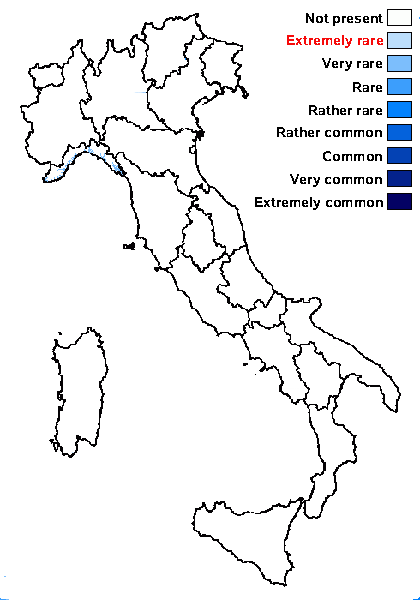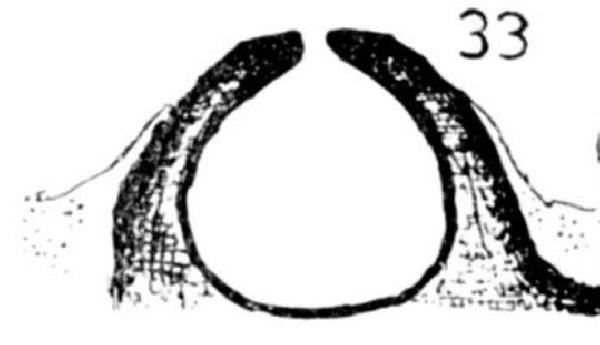Verrucaria prosoplectenchymatica Servít
Preslia, 24: 372, 1952.
Synonyms:
Distribution: N - Lig.
Description: Thallus crustose, episubstratic, dull brown, rimose to areolate, thin to rather thick, partly delimited by a dark brown prothallus, the areoles angular, separated by deep fissures, the sterile ones flat and 0.15-0.3 mm wide, the fertile ones convex and c. 0.5 mm wide. Cortex not developed; algal layer continuous; medulla hardly developed in sterile areoles, thin and pale brown around the perithecia. Perithecia black, immersed in thalline warts, the apical parts naked. Involucrellum extending to base-level, 350-500 µm wide at base, separated in a 15-40 µm thick, black outer layer arching away from exciple and slightly spreading towards base, and a paler, brownish internal part, which is up to 100-150 µm wide at base; exciple subglobose, 0.2-0.3 mm across, the wall pale to dark brown, c. 15 µm thick; hamathecium of mostly simple, 25-35 µm long periphyses and periphysoids, interascal filaments absent; hymenial gel hemiamyloid, I+ red (I+ blue at very low concentrations of I), K/I+ blue. Asci 8-spored, clavate, I-, fissitunicate, the wall thickened above, with an ocular chamber, dehiscent by extrusion of an endotunica to form a delicate rostrum, Verrucaria-type. Ascospores 1-celled, hyaline, ellipsoid to oblong-ellipsoid, 24-30 x 9-14 µm. Photobiont chlorococcoid. Spot tests: K-, C-, KC-, P-, UV-. Chemistry: without lichen substances.
Note: this long-forgotten silicicolous species described from the surroundings of Genova has been recently resurrected by Breuss in the 3rd volume of the Lichen Flora of the Greater Sonoran Region (Nash & al. 2007), where it is reported from southwestern North America, with a good description.
Growth form: Crustose
Substrata: rocks
Photobiont: green algae other than Trentepohlia
Reproductive strategy: mainly sexual
Poorly known taxon in need of further study
Commonnes-rarity: (info)
Alpine belt: absent
Subalpine belt: absent
Oromediterranean belt: absent
Montane belt: absent
Submediterranean belt: absent
Padanian area: absent
Humid submediterranean belt: absent
Humid mediterranean belt: very rare
Dry mediterranean belt: absent

Predictive model
Growth form: Crustose
Substrata: rocks
Photobiont: green algae other than Trentepohlia
Reproductive strategy: mainly sexual
Poorly known taxon in need of further study
Commonnes-rarity: (info)
Alpine belt: absent
Subalpine belt: absent
Oromediterranean belt: absent
Montane belt: absent
Submediterranean belt: absent
Padanian area: absent
Humid submediterranean belt: absent
Humid mediterranean belt: very rare
Dry mediterranean belt: absent

Predictive model
 INDEX FUNGORUM
INDEX FUNGORUM
 GBIF
GBIF


